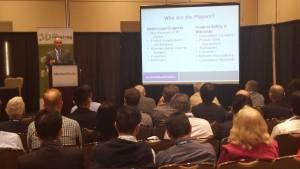 I just caught an insightful and comprehensive talk from intellectual property lawyer and 3D printing evangelist John Hornick on what he feels the impact of 3D printing technology will be on the world of copyrights and trademarks. The talk made me realize that there really are too many people who will seemingly be completely blindsided by the emergence of advanced 3D printing technology and how it will change… everything. While the idea of listening to a lawyer talk about IP law for an hour may seem dry, Hornick is quite an engaging speaker starting a conversation that a lot of people in the 3D Printing industry don’t seem to want to have. His talk was given at this week’s Inside 3D Printing Conference Santa Clara and the hour-long presentation called 3D Printing and The Future (of Demise) of IP laid out a rather bleak vision for proponents of stronger protections for trademarks, patents and copyrights.
I just caught an insightful and comprehensive talk from intellectual property lawyer and 3D printing evangelist John Hornick on what he feels the impact of 3D printing technology will be on the world of copyrights and trademarks. The talk made me realize that there really are too many people who will seemingly be completely blindsided by the emergence of advanced 3D printing technology and how it will change… everything. While the idea of listening to a lawyer talk about IP law for an hour may seem dry, Hornick is quite an engaging speaker starting a conversation that a lot of people in the 3D Printing industry don’t seem to want to have. His talk was given at this week’s Inside 3D Printing Conference Santa Clara and the hour-long presentation called 3D Printing and The Future (of Demise) of IP laid out a rather bleak vision for proponents of stronger protections for trademarks, patents and copyrights.
The beginning of the industrial age marked a dramatic sea change in human society that altered the entire course of the planet, both socially and economically. For thousands of years, humanity was a maker economy founded on the principles of individual artisans and craftsmen supplying their community with the goods that they needed to survive, with only unusual or locally unavailable products being imported, often at great expense. Economies were mostly local, and fueled almost entirely by their own populations’ ability to serve the needs of themselves or their neighbors. But industrialization and mass production devastated local economies and pulled them kicking and screaming into global economies.
These global economies have, for the most part, served us pretty well. They transformed us into, what I believe to be, far better societies that are connected by globally shared interests and technology that eliminates the fear of the unknown from our neighbors near and far. While many would argue that the world is a far darker place today than it was a thousand years ago, I believe that to be rather naive, and clearly ignorant of our planet’s history. Every advancement brings with it a series of downsides, it is both inevitable and simply part of the way that society works. But while mass industrialization transformed us into, as Hornick calls it, buyers not makers, it has also brought with it the lowest number of global citizenry living in poverty in all of recorded history. The world will never be perfect, but advancing into the industrial age has inarguably left humanity as a whole better off than our predecessors in many of the ways that truly matter.
But as industrialization now becomes the norm, once again, humanity’s ability to evolve and outgrow the old ways of doing things is once again threatening to alter the world on a massive scale. Hornick believes that 3D printing technology will change us from buyers back into the makers that we once were, simply makers with a much different community to service. When you can make anything in your own home, why would you pay someone else to make it for you? And while the idea of 3D printers that can produce virtually anything that we need is still a ways off, it is at this point an inevitability. We are closer than ever to 3D printable electronics, 3D printing with multiple, combinable materials and the ability to 3D scan and replicate products from the home. Intellectual property, Hornick says, is becoming irrelevant and will be replaced with customization.
 Hornick suggests that once again the makers will be king, and the world’s individual artisans and craftsmen will become more important than the actual products that they manufacture. Intellectual property would effectively cease to exist for those products and instead IP would be the domain of infrastructure, ideas and of course the raw materials used to create things. And Hornick pulled out some rather startling statistics to back that up, including the fact that even with the existence of inexpensive streaming services and iTunes, an estimated 95% of the music downloaded from the internet is pirated. It is just an uncomfortable reality of humanity that we are opportunistic creatures, and much like water we will take the path of least resistance almost every time.
Hornick suggests that once again the makers will be king, and the world’s individual artisans and craftsmen will become more important than the actual products that they manufacture. Intellectual property would effectively cease to exist for those products and instead IP would be the domain of infrastructure, ideas and of course the raw materials used to create things. And Hornick pulled out some rather startling statistics to back that up, including the fact that even with the existence of inexpensive streaming services and iTunes, an estimated 95% of the music downloaded from the internet is pirated. It is just an uncomfortable reality of humanity that we are opportunistic creatures, and much like water we will take the path of least resistance almost every time.
It is worth noting that Hornick isn’t alone in projecting such a radical shift in the way that intellectual property and manufacturing will work. His thoughts were echoed at another presentation from the Inside 3D Printing Conference by Husch Blackwell partners San Digirolamo and Brandan Mueller. In their excellent presentation called The Shape of Things to Come – Strategies for Success in the Age of 3D Printing they touched on the eventual and inevitable changes that the democratization of manufacturing that will come with the advancement of 3D printing technology. Digirolamo, Mueller and Hornick all seem to be on the same page when it comes to the disruptive effects that having no entry barriers and no economy of scale paired with cost neutral complexity and customization will have on manufacturing and mass production.
All this being said, it will be a while before any of this happens, and it isn’t likely that the current owners of most intellectual properties will go quietly, especially not with current copyright patent laws firmly on their side. Technology research and analysis firm Gartner is projecting that by 2018 3D printing related intellectual property losses and lawsuits will reach 100 billion dollars. And while the last few years we’ve seen 220 3D printing related patents expire and opened up to the open source community, there are still over 12,000 patents hanging around. So we’re still decades away both technologically, and culturally from this shift, but just as IKEA killed the local furniture maker, it seems that 3D printing will kill traditional manufacturing and distribution.
John Hornick gives presentations on 3D printing technology and how it relates to intellectual property at 3D printing and tech conventions all over the world, so if you are given the opportunity to hear him speak make sure that you take it. I can’t recommend it enough. Hornick is also releasing a book next month called 3D Printing Will Rock the World on the very subject, so iIll be covering his thoughts and insights more in depth next month. Discuss this story in the 3D Printing IP forum thread on 3DPB.com.
Subscribe to Our Email Newsletter
Stay up-to-date on all the latest news from the 3D printing industry and receive information and offers from third party vendors.
Print Services
Upload your 3D Models and get them printed quickly and efficiently.
You May Also Like
Nikon SLM Solutions Sells SLM 500 to Primary Weapon Systems to Expand Suppressor Production
Primary Weapons Systems (PWS) is a Boise, Idaho-based manufacturer of suppressors, firearms, and related components. A subsidiary of Vigilant Gear and a sister company to aftermarket Glock slide manufacturer Lone...
3DPOD 261: Tooling and Cooling for AM with Jason Murphy, NXC MFG
Jason Murphy´s NXC MFG (Next Chapter Manufacturing) is not a generalist service; instead, the company specializes in making tooling. Using LPBF and binder jet, the company produces some of the...
HP and Firestorm Labs Form Partnership to Use Multi Jet Fusion 3D Printers in Deployable Factories
HP Inc., maker of a range of additive manufacturing (AM) solutions including the Multi Jet Fusion (MJF) ecosystem, has announced a partnership with Firestorm Labs, a developer of containerized, deployable...
3D Printing News Briefs, July 2, 2025: Copper Alloys, Defense Manufacturing, & More
We’re starting off with metals in today’s 3D Printing News Briefs, as Farsoon has unveiled a large-scale AM solution for copper alloys, and Meltio used its wire-laser metal solution to...


































